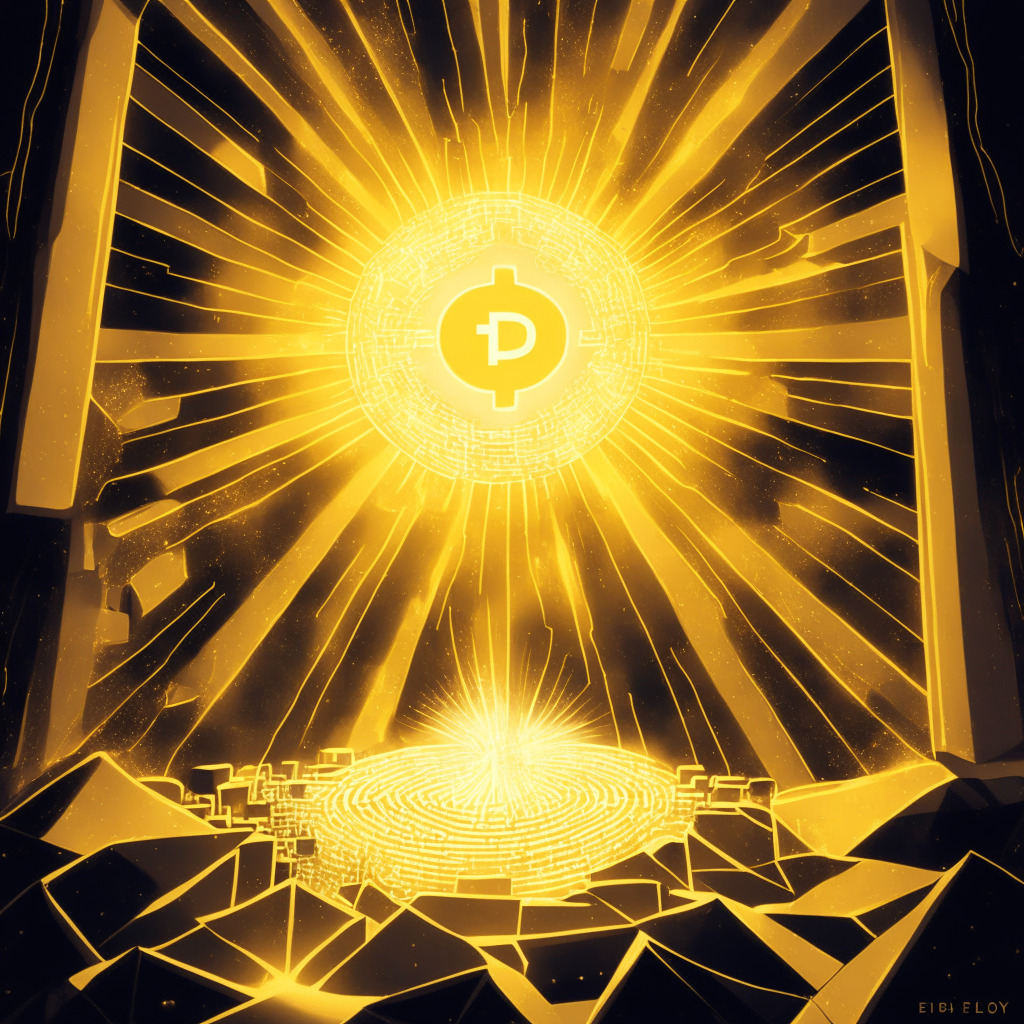Tether, the company behind the popular USDT stablecoin, reportedly lends out stablecoins at a high level, with loans amounting to $5.5 billion as of end-June 2021. However, concerns arise given the lack of clear transparency about the firm’s liquidity, capital reserves, and loan specifics. Reassurance comes from Tether’s claim that its tokens are fully supported by cash or liquid assets.
Search Results for: Ether
The Baffling Surge in Ethereum Gas Fees: Binance’s Role and the Crypto Community’s Reactions
The Ethereum network recently experienced a drastic surge in gas prices due to 140,000 transactions directed towards a Binance wallet, leading to extensive costs for users. This resulted in the Ethereum network momentarily being the largest gas user and Binance losing around 530 ETH ($840,000) in gas fees.
Spot Ethereum ETFs: A Pending Revolution or a Regulatory Nightmare?
The U.S. SEC has initiated a review of two applications for spot Ethereum ETFs from asset managers ARK Invest and VanEck. The applications propose pegging the price of Ether against a reference rate and do not guarantee approval. The SEC has expressed preference for futures-based ETFs for better investor protections. However, regulatory challenges and concerns over market manipulation and asset volatility persist. Despite such hurdles, Spot Ethereum ETFs could potentially boost liquidity and interest in the Ethereum ecosystem.
China’s Capital Flight: The Potential Bitcoin Boom and the Changing Ethereum Landscape
“In the wake of China’s significant capital flight and a weakening Yuan, the Bitcoin market may see a surge as investors search for alternatives to the feeble domestic market. Despite China’s strict capital controls, crypto may emerge as a lucrative option. However, prevailing uncertainties about the present impact of capital flight on Bitcoin, compared to 2017, remain. Industry changes in the Ethereum universe with the sunsetting of toolkits, Ganache and Truffle, also reflect this blockchain uncertainty.”
From Ethereum’s Nostalgia to MetaMask Snaps: A New Dawn for Developers
Ethereum is witnessing the end of an era with Truffle and Ganache’s sunsetting. However, a new dawn lies ahead with MetaMask Snaps. These changes reflect Ethereum’s ability to evolve and adjust to new opportunities and challenges while promising an exciting future for developers.
Tether’s Undisclosed Investment in Northern Data: A Blockchain Breakthrough or Transparency Crisis?
Tether has made an undisclosed investment in German-based crypto miner, Northern Data Group, potentially involving AI, P2P communications, and data storage solutions. Despite past controversies and questions around its financial management and transparency, this move could signify a turning point for Tether and have significant implications for the blockchain industry.
Ethereum’s Uptick Dilemma: Past Expectations Vs. Future Pivots
Despite witnessing a 36% year-to-date price increase in 2023, Ethereum’s price lags significantly behind Bitcoin’s, sparking concern among investors. Even protocol upgrades and the shift to Proof-of-Stake consensus couldn’t sustain Ethereum’s price rise. However, the proposed Ether ETF by ARK Invest and 21Shares, along with Canto’s migration to Ethereum’s layer-2, indicate potential catalysts for recovery.
Unleashing the Potential and Pitfalls of Chainlink’s Entry into Ethereum Layer 2
Chainlink’s entry into Ethereum layer 2, Arbitrum, will facilitate cross-chain DApp development, aiding high-throughput, cost-efficient scaling. The addition of Chainlink’s Cross-Chain Interoperability Protocol (CCIP) on Arbitrum One should unlock various use cases like cross-chain tokenization and blockchain gaming.
Binance’s Ethereum Gas Spend Spree: A Technical Glitch or Evidence of Underlying Inefficiencies?
Binance reportedly spent an astonishing 530 Ether on gas fees in a day due to unexpected spikes in Ethereum network gas prices. This large expenditure, linked to the “Binance 14” wallet, provoked reactions and led to questions about the trading platform’s technology and coin management capabilities.
Ethereum’s Recent Price Dip: A Buying Opportunity or a Shift towards Meme Tokens?
Despite a recent 1% drop in price, market indicators suggest that Ethereum (ETH) is ‘oversold’, signalling a potential buying opportunity. ETH’s price could surge following the anticipated launch of the Holesky testnet on September 28, with strong fundamentals indicating a year-end price of $1,800.
Resilience in Cryptocurrency: The Curious Case of Rising Stablecoin Loans by Tether Despite Planned Elimination
“In an intriguing move, Tether has seen a rise in stablecoin loans despite an earlier announcement to eliminate these. The reason being short-term loan requests from long-standing clients. Transparency issues have arisen, however, Tether defends the over-collateralization of these loans while gaining market dominance and profit. This venture provides lessons on cryptographic money lending.”
Whale-Spotted: ETHER Market Drawn in Massive Naked Buy -A Bullish Joust or Deep Pitfall?
An investor speculated to be a whale has been trading substantial call options, acquiring nearly 92,600 ETH call option contracts valued at about $150 million on Deribit. This activity, despite the gloomy phase for ETH, demonstrates the optimistic outlook of some whales on the future of the ether market.
Undervalued Ether? Evaluating Ethereum’s True Value in Light of Layer 2 Adoption
“According to RRx, Ether, the cryptocurrency of the Ethereum blockchain, is trading at a 27% discount to its intrinsic value. This valuation is based on a modified Metcalfe law model, considering both Ethereum’s mainnet active users and the usership of its layer 2 scaling networks.”
Ethereum’s Holesky Testnet Launch Misfires: A Hiccup or Long-Term Concern?
Ethereum’s anticipated test network, Holesky, faced a launch setback due to a misconfiguration, resulting in a two-week delay. Despite being intended to address Ethereum’s scaling issues and allow for increased validators, the event highlighted vulnerabilities. However, the existing Goerli testnet remains functional, supporting continued application testing. This incident does not affect Ethereum’s subsequent hard fork, Dencun.
Ethereum’s Prospects Amid Testnet Troubles & The Rise of Non-Traditional Crypto Assets
“Ethereum’s recent trading volume exceeded $2.6 billion, boosting its price over the $1,600 benchmark. Despite a hiccup in the Holesky testnet launch due to data entry errors, Ethereum’s mainnet remains unaffected emphasizing the need for testnets in improving validation and staking processes.”
Ethereum’s Holseky: Innovation Towards Scalability or a Step Towards Centralization?
The Ethereum blockchain is introducing Holesky, the largest test network, set to resolve scalability issues before projects go live. Despite its high potential and efforts in scaling and energy use, concerns remain about Ethereum’s centralized nature and financial barriers for individual validators.
Ethereum Protocol Witnesses Impressive Surge: What this Means for Ether’s Future
The Ethereum network recently witnessed an impressive surge in daily active addresses, hitting 1.088 million. This was significantly higher than the usual 300,000-450,000 range. This spike could be the start of a robust on-chain activity trend and could provide a price boost for Ethereum in the future. However, factors like SEC regulations and ETF approvals will influence its course.
Ethereum Market Dynamics: Potential Climb vs Increasingly Uncertain Terrain
“The Ethereum market exhibits dynamism, with ETH showing resilience after a drop and subsequent 6% rebound. Despite macroeconomic factors possibly boosting cryptocurrencies, concerns over high network fees, regulatory uncertainties and potential U.S. indictment of popular crypto exchange Binance, persist.”
Ethereum’s Holesky vs BitGo’s Bitcoin-Only Trust: Innovations Shaping Blockchain’s Future
Ethereum’s new testnet ‘Holešky’ aims to support staking, infrastructure and protocol development. Its launch, with 1.6 billion ETH available for validators, signals a significant evolution in the blockchain landscape. This network is designed to ease the testing needs of broader Ethereum’s technological advancements. Despite its potential, the success of Holešky isn’t guaranteed due to unpredictable blockchain challenges.
Ethereum’s New Testnet Holesky: A Gargantuan Leap in Blockchain Scalability and Sustainability
“Ethereum developers initiate new test network, Holesky, doubling the capacity of the main network. Commemorating Ethereum’s transition to a ‘proof-of-stake’ blockchain, Holesky offers an environment for developers to experiment and address scalability issues, aiming to replace the existing Goerli testnet by 2024.”
Ethereum’s Bumpy Journey: From Proof-of-Work to Proof-of-Stake and Beyond
A pivotal upgrade known as the Merge transitioned Ethereum from a proof-of-work (PoW) consensus mechanism to a proof-of-stake (PoS), causing a net supply decrease of 299,922.50 ether. The PoS mechanism needs users to hold ether to validate transactions and earn rewards. This eliminated much miner supply and made Ethereum more eco-friendly. However, despite these changes, ether’s market values have stagnated.
Ethereum’s Proof-of-Stake Transition: A Year in Review and a Look into the Future
“Ethereum transitioned to the proof-of-stake system reducing power consumption by over 99% and making the network economically deflationary. However, anticipated price surge due to deflationary pressure hasn’t materialized swiftly. Liquid staking providers control significant amounts of staked Ether, raising potential centralization concerns.”
Layer N’s Potential Revolution: Spotlight On the $5 Million Seed Funding and the Future of Ethereum
“The Layer N announced its $5 million seed funding round, led by Peter Thiel’s Founders Fund and dao5. Layer N intends to offer a more efficient layer for Ethereum, characterized by high transaction throughput and lower transaction fees, aiming to contest traditional financial networks. Questions arise whether it can overcome Ethereum’s inherent challenges.”
Revamping Ethereum’s Staking Infrastructure: Is SSV.network the Solution to Pool Decentralization and Key Security?
“SSV.network, in partnership with the Ethereum Foundation, recently launched its mainnet aiming to decentralize Ethereum staking pools. Leveraging Distributed Validator Technology, it aims to increase validator resilience, enhance private key security, and minimize the risks of validator downtime.”
Ethereum Co-Founder’s Optimism Amidst Crypto Regulation Uncertainties: A Balanced Future?
Joseph Lubin, co-founder of Ethereum and CEO of ConsenSys, maintains a positive outlook on cryptocurrency’s adoption in the US. He draws parallels to the country’s past approach to emerging technologies like the internet, insisting that “clear heads will prevail” amid industry unrest and regulatory ambiguities.
Ethereum Staking Redefined: Decentralized Pathway Led by SSV Network Challenges the Norms
“ssv.network has introduced a blockchain solution emphasizing on liquid staking, aiming for a higher level of decentralization. Given the centralization concerns around Ethereum’s staking mechanism where top exchanges and selected entities hold majority of staked ETH, SSV’s mainnet proposes an approach to mitigate these problems. This new system, facilitated by SSV smart contracts, encourages multiple operators’ involvement without needing external coordination.”
Unveiling Polygon 2.0: Scaling Ethereum’s Future or Shaking Its Foundation?
Ethereum layer 2 developer, Polygon Labs, commences Polygon 2.0 ecosystem aimed at establishing an interconnected Ethereum system with high throughput and low fee transactions. This ecosystem evolution highlights the adaptability of blockchain technology but raises questions about the impacts on established contracts and practices.
Unraveling Ethereum’s Market Volatility: Active Addresses Surge Amid Price Decline
“Market analysts report a significant increase in daily active Ethereum addresses, marking the second-highest in its history and indicating potential market volatility. Despite Ethereum’s price decline, escalated interest among institutional investors and its stronghold in the DeFi ecosystem are bolstering its outlook.”
Navigating Uncharted Waters: US Dollar Inflation, Ethereum’s Rise, and the Promise of New Coins
“Ethereum’s blockchain foundation, Ether (ETH), exhibits recovery with a recent 5% rise from low figures and a $1530 valuation. Despite a near-term unfavorable outlook, the prospects of future ETF approvals and ETH’s adoption rate suggest potential growth, even towards a $10,000 mark.”
Ethereum’s New Holesky Testnet: A Step Towards Optimized Network Scalability and Enhanced Testing
Ethereum is set to unveil a new testnet, Holesky, which promises larger capacity than its existing networks, Sepolia and Goerli. The new testnet aims to address potential scaling issues and accommodate more extensive testing for Ethereum’s growing developer community. Named after a Prague train station, Holesky’s significant size would provide a realistic environment for infrastructure and core protocol upgrade testing, targeting to enhance Ethereum’s resilience against unexpected obstacles.
Is PayPal’s Ethereum-based Stablecoin, PYUSD, Truly 100% Asset-Backed? Examining the Claims
“PayPal’s Ethereum-based stablecoin, PYUSD, has full asset backing, primarily from U.S. Treasury reverse repurchase agreements, says Paxos. Though overcollateralization safeguards assets, it could limit profits. Some PYUSD assets are in uninsured cash deposits, reflecting typical banking risks. PYUSD’s transparent operation may soothe some investors while raising others’ skepticism.”
Navigating the ETF Race: A Deep Dive into Hashdex’s Ethereum ETF Strategy and The SEC’s Pending Approval
The Nasdaq stock exchange is seeking SEC approval to list the Hashdex Nasdaq Ethereum ETF, an innovative approach to crypto investment within regulatory frameworks. This ETF will incorporate spot ether holdings and futures contracts, aiming to reflect the daily fluctuations in the Nasdaq Ether Reference Price.































